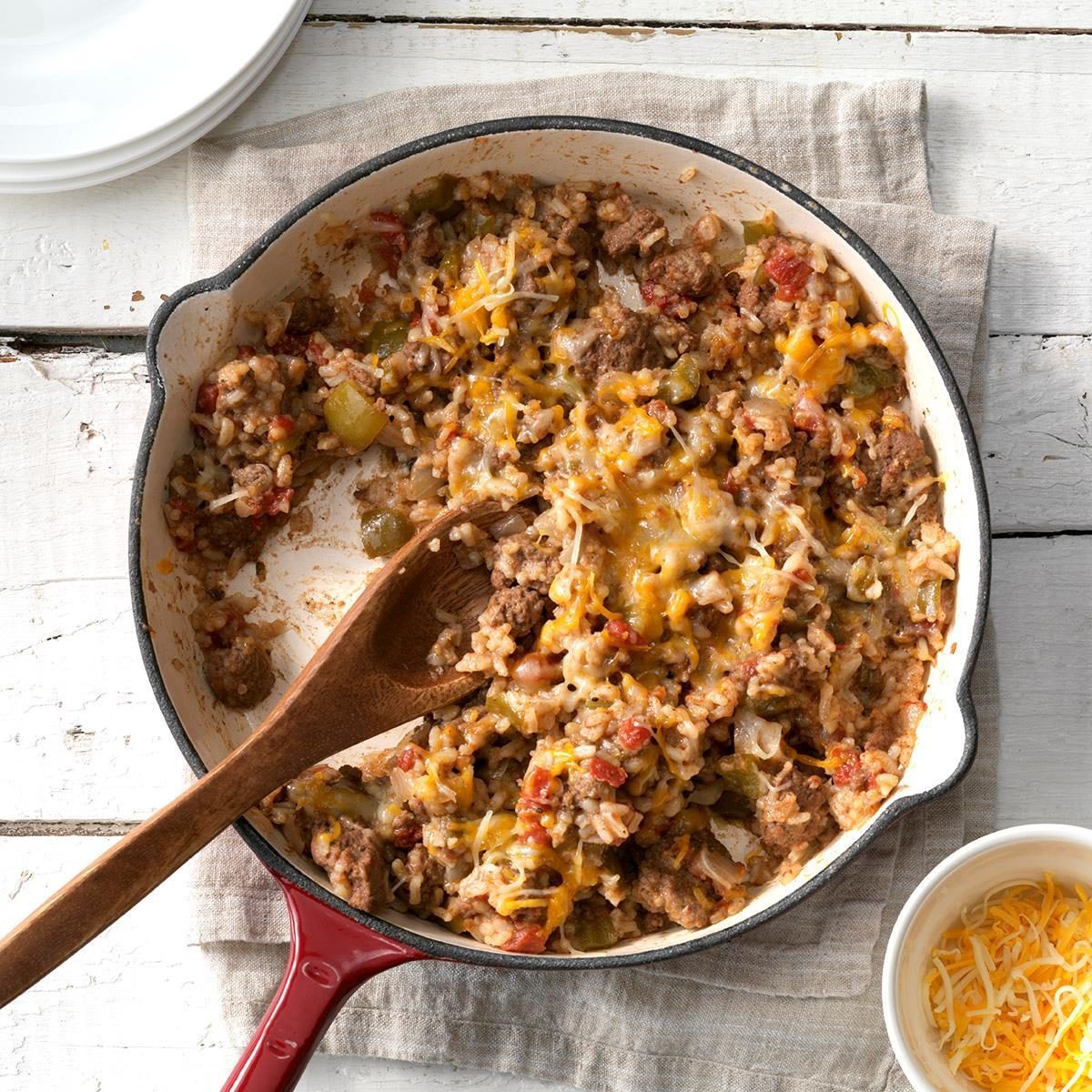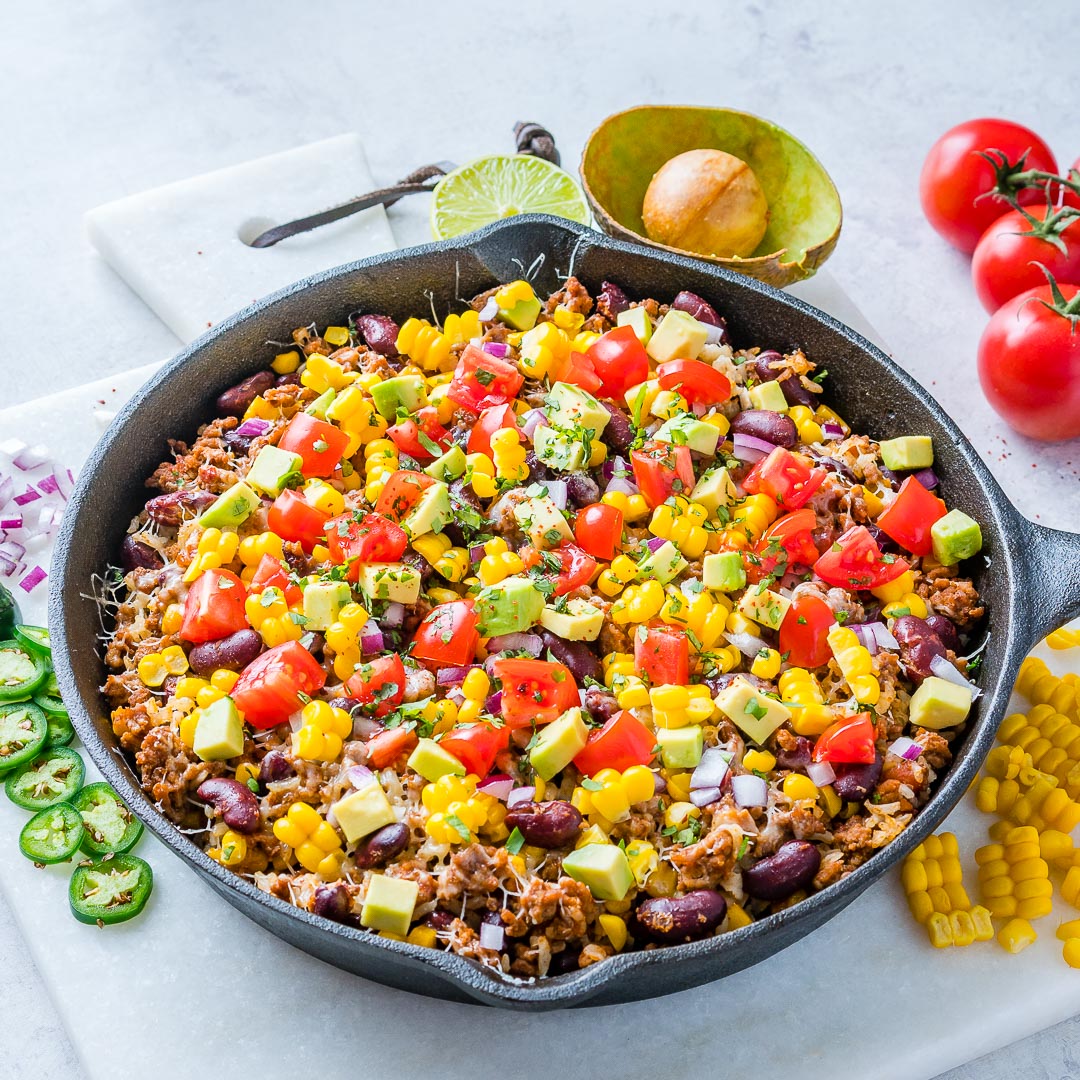Skillet Beef and Rice: A Hearty, Versatile, and Delicious One-Pan Meal

Skillet beef and rice is the epitome of comfort food. A hearty, flavorful dish that’s surprisingly easy to make, it’s a weeknight staple and a crowd-pleaser for both casual gatherings and family dinners. The beauty of this dish lies in its adaptability; you can customize it to your liking, incorporating different vegetables, spices, and cuts of beef to create a unique culinary experience every time. This article will delve into the nuances of preparing this classic dish, exploring various techniques, ingredient variations, and serving suggestions, transforming your understanding of this seemingly simple meal.
Understanding the Foundation: Ingredients and Their Roles
The core components of a successful skillet beef and rice are surprisingly few, yet each plays a crucial role in achieving the desired texture and flavor profile.
-
Beef: The choice of beef significantly impacts the overall taste and cooking time. While stew beef, with its higher fat content and connective tissues, renders beautifully in a skillet, resulting in a tender, rich outcome, leaner cuts like sirloin or flank steak can also be used, provided they are cut into smaller, bite-sized pieces to ensure even cooking. The fat from the beef contributes significantly to the overall richness of the dish, browning the meat and adding depth of flavor. However, if using leaner cuts, you may want to supplement with a tablespoon or two of oil.
-
Rice: Long-grain rice, such as basmati or jasmine, is generally preferred for its ability to retain its individual grains while absorbing the flavorful beef broth. Short-grain rice, while delicious, tends to become mushy when cooked in this manner. The rice absorbs the juices from the beef and vegetables, creating a cohesive and flavorful dish. Pre-rinsing the rice is recommended to remove excess starch and prevent it from becoming overly sticky.
-
Broth/Stock: Beef broth or stock forms the base of the dish, providing moisture and enhancing the overall flavor. The richness of the broth directly impacts the final product, so opt for a high-quality broth for the best results. Chicken broth can be substituted, but it will alter the flavor profile slightly, making it less intensely beefy.
-
Aromatics: Onions, garlic, and other aromatics such as carrots, celery, and bell peppers form the flavor base of the dish. These ingredients are sautéed before adding the beef, releasing their aromatic compounds and creating a foundation for the rich flavors to develop. The choice of aromatics can be tailored to individual preferences, adding a touch of sweetness, sharpness, or earthiness.

-
Spices and Seasonings: A blend of spices and seasonings elevates the dish from simple to extraordinary. Common additions include salt, pepper, paprika, cumin, chili powder, or even a dash of Worcestershire sauce. Experimenting with different spice combinations allows for endless variations, catering to different palates and preferences.


Mastering the Technique: A Step-by-Step Guide
The beauty of skillet beef and rice lies in its simplicity. However, following a few key steps ensures a perfectly cooked and flavorful meal.
-
Preparation is Key: Begin by preparing all your ingredients. Dice the beef into uniform-sized pieces, chop the vegetables finely, and measure out the rice and broth. This ensures a smooth and efficient cooking process.
-
Browning the Beef: Season the beef generously with salt and pepper. Heat a tablespoon or two of oil in a large, oven-safe skillet over medium-high heat. Add the beef in batches, ensuring not to overcrowd the pan, and brown it on all sides. This step develops a rich crust and enhances the flavor. Remove the browned beef from the skillet and set aside.
-
Sautéing the Aromatics: Add the chopped onions, garlic, and other chosen vegetables to the skillet and sauté until softened and slightly caramelized. This step builds the flavor foundation for the dish.
-
Building the Flavor: Stir in the spices and seasonings, cooking for a minute or two to release their aromas. This step infuses the vegetables with flavor and creates a fragrant base for the rice and beef.
-
Combining the Ingredients: Return the browned beef to the skillet. Add the rinsed rice, stirring to combine with the vegetables and spices. Pour in the beef broth, ensuring the liquid level is slightly above the rice.
-
Simmering to Perfection: Bring the mixture to a boil, then reduce the heat to low, cover the skillet tightly, and simmer for approximately 20-25 minutes, or until the rice is cooked through and the liquid is absorbed. Avoid lifting the lid during the simmering process to maintain the moisture and allow the rice to cook evenly.
-
Rest and Serve: Once cooked, remove the skillet from the heat and let it rest, covered, for 5-10 minutes. This allows the rice to finish absorbing the remaining liquid and creates a more tender and flavorful dish. Fluff the rice with a fork before serving.
Variations and Customization: Expanding Your Culinary Horizons
The versatility of skillet beef and rice is its greatest strength. Experiment with different ingredients and techniques to create unique and delicious variations.
-
Vegetable Variations: Incorporate a wide array of vegetables such as mushrooms, zucchini, green beans, peas, or corn. Roasted vegetables, added at the end, can add a delightful smoky flavor.
-
Spice Variations: Explore different spice blends to create unique flavor profiles. A blend of cumin, coriander, and turmeric creates a warm and earthy flavor, while a touch of cayenne pepper adds a spicy kick.
-
Beef Variations: Experiment with different cuts of beef, adjusting the cooking time accordingly. Ground beef can be used, but it requires a slightly different approach, often involving browning it completely before adding the other ingredients.
-
Add-ins: Elevate the dish with additions like chopped fresh herbs (parsley, cilantro), a squeeze of lemon juice, or a dollop of sour cream or Greek yogurt. Cheese, such as cheddar or Monterey Jack, can be stirred in during the last few minutes of cooking.
-
One-Pot Wonders: Consider adding other ingredients directly to the skillet, such as diced tomatoes, kidney beans, or even a splash of red wine for a richer, more complex flavor.
-
Global Influences: Incorporate global flavors by adding ingredients like soy sauce, ginger, and garlic for an Asian-inspired twist, or cumin, chili powder, and corn for a Mexican-inspired variation.
Serving Suggestions: Completing the Culinary Experience
Skillet beef and rice is a complete meal in itself, but it can be complemented with various side dishes and accompaniments to enhance the dining experience.
-
Simple Salads: A fresh green salad with a light vinaigrette provides a refreshing contrast to the richness of the main dish.
-
Steamed Vegetables: Steamed broccoli, green beans, or asparagus add a healthy and flavorful side.
-
Bread: A crusty bread or rolls are perfect for soaking up the delicious beef and rice juices.
-
Sauces and Condiments: A dollop of sour cream, a sprinkle of fresh herbs, or a drizzle of hot sauce can add extra flavor and texture.
Conclusion: A Culinary Journey Awaits
Skillet beef and rice is more than just a meal; it’s a culinary journey filled with endless possibilities. Its simplicity, adaptability, and deliciousness make it a staple in kitchens worldwide. By understanding the fundamental principles and exploring the various variations, you can elevate this classic dish to new heights, creating a personalized culinary experience that satisfies both your palate and your soul. So, gather your ingredients, embrace the process, and embark on a delicious adventure with this versatile and satisfying one-pan wonder.

Video tentang Skillet Beef and Rice: A Hearty, Versatile, and Delicious One-Pan Meal
Penutup
Therefore, we hope this article has provided valuable insights on Skillet Beef and Rice: A Hearty, Versatile, and Delicious One-Pan Meal. We appreciate your attention to our article . See you in our next article!

